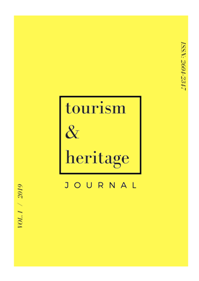Tourism&Theatre. To be or not to be?
DOI:
https://doi.org/10.1344/THJ.2019.1.8Palabras clave:
Cultural Tourism, Destination Management, Tourism&Theatre, Touristic Product, Urban DestinationResumen
This project seeks to study the Tourism&Theatre phenomenon. The main proposal of the research is to highlight strategies of how an urban destination can make, from its inherent theatre products and theatrical culture, a tourist attraction.
The methodology undertaken has been an exploratory search of qualitative information thanks to exhaustive in-depth interviews with theatrical and tourism professionals and companies. Currently, London and New York are the most successful examples of Tourism&Theatre destinations. However, examples from other western destinations are devising alternatives strategies.
Surprisingly, the conclusion that the project has unearthed is that tourism accessibility is the key to Tourism&Theatre phenomenon. In destinations where theatre is not yet a tourism attraction, tourist managers should focus on making the art form more reachable for tourist consumption (content accessibility, communication campaigns, distribution channels, etc.). Thus, the creation of a tourism accessibility company applied to theatre could be the most feasible strategy to adopt.
Citas
Albertí, X. (2016, June, 20). El turisme a Barcelona: la ciutat com a escenari. [Video file]. Retrieved from: http://www.cccb.org/es/multimedia/videos/el-turismo- en-barcelona-la-ciudad-como-escenario/224253 (accessed on 15 October 2018).
Barbieri, C. & Mahoney, E. (2010). Cultural Tourism Behaviour and Preferences Among the Live-Performing Arts Audience: an Application of the Univorous- Omnivorous Framework. International Journal of Tourism Research, 12(1), 481-496.
Bennett, S. (2005). Theatre/Tourism. Theatre Journal, 57(3), 407-428.
Chias, J. (2005). El Negocio de la Felicidad. Desarrollo y Marketing Turístico de Países, Regiones, Ciudades y Lugares. (1rst ed.). Madrid, Spain: Pearson Educación, S. A.
Huges, H. (1998). Theatre in London and the Relationship With Tourism. Tourism Management, 19 (5), 445-452.
Gapinski, J. H. (2006) Tourism's Contribution to the Demand for London's Lively Arts. Applied Economics, 20, 957-968.
Kennedy, D. (1998). Shakespeare and Cultural Tourism. Theatre Journal, 50(2), 175–188.
Leguizamón, M. (2013). Impacto Turístico del Festival Iberoamericano de Teatro de Bogotá. Pasos. Revista de Turismo y Patrimonio Cultural, 12 (1), 73-87.
Loukia, M. & Amalia, K. (2014). Ancient Greek Drama and its Architecture as Means to Reinforce Tourism in Greece. Procedia - Social and Behavioral Sciences, 148, 573-578.
Osácar, E. (2017). Cómo poner en valor el patrimonio cultural y natural en proyectos turísticos. In L. Coma & J. Santacana (coords.), Ciudad educadora y turismo responsable.. Gijón: Trea.
Smith, A. (2013, 4th of November). Theatre is a greater driver of tourism than sport – VisitBritain report. The Stage. Retrieved from https://www.thestage.co.uk/ news/2013/theatre-greater-driver-tourism-sport-visit-britain-report/. (accessed on 15 October 2018).
Theatre in Paris (n.d.). Theatre in Paris. Retrieved from https://www.theatreinparis.com/. (accessed on 15 October 2018).
Zieba, M. (2016). Tourism flows and the demand for regional and city theatres in Austria. Journal of Cultural Economics, 40 (2), 191–221.Descargas
Publicado
Cómo citar
Número
Sección
Licencia
Derechos de autor 2019 Lluís Santamarta Espuña

Esta obra está bajo una licencia internacional Creative Commons Atribución 4.0.
El/la autor/a que publica en esta revista está de acuerdo con los términos siguientes:- El/la autor/a conserva los derechos de autoría y otorga a la revista el derecho de primera publicación de la obra.
- Los textos se difundirán con la licencia de reconocimiento de Creative Commons que permite compartir la obra con terceros, siempre que éstos reconozcan su autoría, su publicación inicial en esta revista y las condiciones de la licencia.




